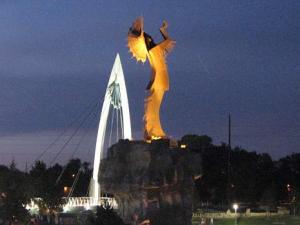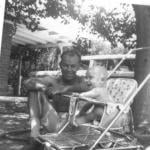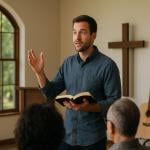Have you ever walked into a space – an empty, quiet space, or even a space with people – and thought, “Something is happening here”?
You sense a mood. There’s a feeling in the air, and no one is saying anything that helps with the details.
There is a secret hiding behind the eyes of a family member. Is it a surprise party? Or something they don’t want to talk about?
We sense that an argument took place moments before we walked into the room. Who started it? What changed as a result?
 Much of our life is lived in the space between words, actions, and all outward expressions.
Much of our life is lived in the space between words, actions, and all outward expressions.
Much of the spiritual life also happens in this space.
In educational theory, you can refer to this as “null curriculum.” Null curriculum is everything that isn’t specifically created content.
But it is specific.
The way the seats are set up in a classroom is an example. When we choose a paint shade like blue or green that is calming and energizing, that is an example of creating null curriculum. The amount of light. Even the way a space smells conveys, allows, and even educates.
I’m beginning to believe that much of our spiritual life is either limited or enabled by the null curriculum we enable in our lives.
The belief in this empty-not-empty space, the null curriculum, comes from the wider story of the Christian Scriptures.
The people of Israel are wandering folk, carrying promises of land and safety, as well as God dwelling with them.
“Dwelling” implies “space.”
The battles and sacrifices, the rituals and rites, of Israel’s history emanate from the discussion of space. When God moves into the neighborhood (see Leviticus), a “null curriculum” is created. Something is conveyed by the cloud and the fire of Exodus, the tent of the tabernacle is built with symbols and structures that teach reverence.
The structure is simply materials formed with skill. It is the spaces that the materials create that heighten and guide the people towards the Divine.
Unlike the Israelites in the wilderness or the people worshiping in the Temple, many of us have a choice about our own “null curriculum.” The spaces we occupy, the stuff we put in our spaces, and even the posture we take physically when it comes to prayer and worship.
In fact, it is the null curriculum – the spaces – where we learn who God is.
When we are confronted with our own restlessness – whether for justice or just for something “different” – what we need most is space.
It is in the unspoken, in the null curriculum, where we have time and energy to give to our pain through the practice (and I’d say “discipline”) of lament.
When we adopt a vision to become like Jesus when it comes to anger, lust, and greed, the null curriculum is key. The unspoken acts and motivations that lead us to fast, or to consider the object of our lust is a person who is built for more than just our satisfaction.
The null curriculum is not what Jesus says, as much as what Jesus doesn’t say.
Same with action – the inaction is the graduate-level lesson in the life of God in the world.
Today, we are called to investigate the space we create for ourselves.
Do we have room for lament? Not “Do we lament,” but even if we wanted to lament would we have space in our life and worship to do so?
Have we created the room for the “null curriculum” that leads to lament?
What about the space where patience, love, and civility can begin to blossom and grow?
The spaces in our life are as instructional and strengthening as any word, action, or lesson we might learn.
Where are the spaces – the null curriculum – of your life?
(Photo by Robert Ruggiero on Unsplash)















